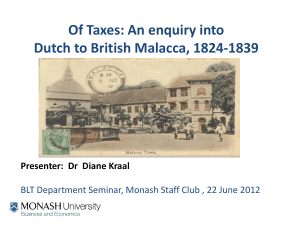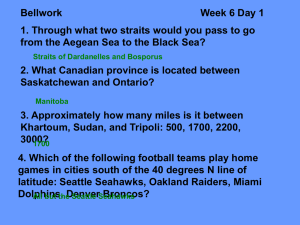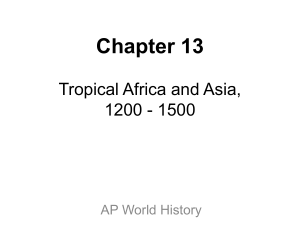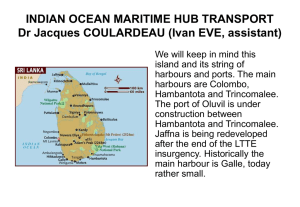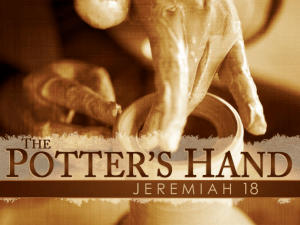Analysis of Carrying Capacity and Critical Governance Strategies for
advertisement
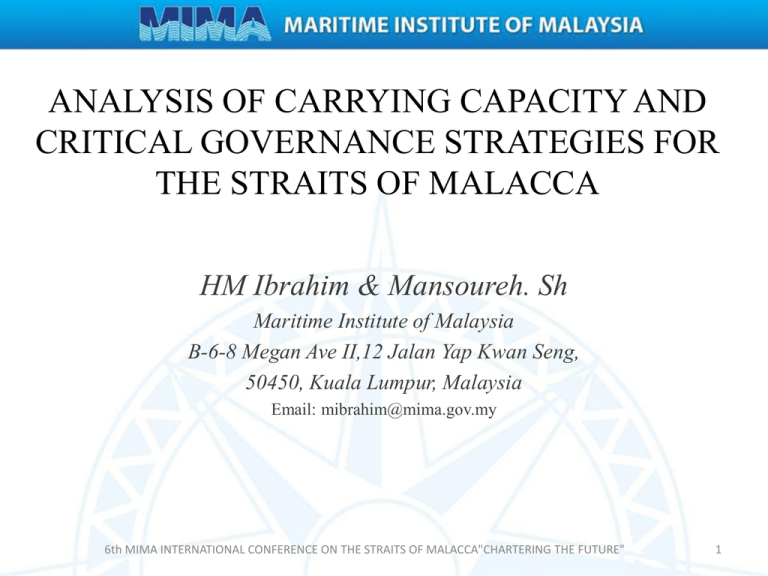
ANALYSIS OF CARRYING CAPACITY AND CRITICAL GOVERNANCE STRATEGIES FOR THE STRAITS OF MALACCA HM Ibrahim & Mansoureh. Sh Maritime Institute of Malaysia B-6-8 Megan Ave II,12 Jalan Yap Kwan Seng, 50450, Kuala Lumpur, Malaysia Email: mibrahim@mima.gov.my 6th MIMA INTERNATIONAL CONFERENCE ON THE STRAITS OF MALACCA"CHARTERING THE FUTURE" 1 OUTLINE • Introduction o o • • • • The Setting Importance of Straits of Malacca Shipping traffic scenario Carrying Capacity of the Straits Critical Governance Strategies Summary & recommendations 6th MIMA INTERNATIONAL CONFERENCE ON THE STRAITS OF MALACCA"CHARTERING THE FUTURE" 2 Maritime Institute Of Malaysia (MIMA) 6th MIMA INTERNATIONAL CONFERENCE ON THE STRAITS OF MALACCA"CHARTERING THE FUTURE" 3 VISION “To be a Centre of Excellence for Maritime Policy Research” 6th MIMA INTERNATIONAL CONFERENCE ON THE STRAITS OF MALACCA"CHARTERING THE FUTURE" 4 • Established in July 1993 • MIMA is a Maritime Policy Research Institute to further national interests in the maritime sector • MIMA takes a comprehensive approach in dealing with maritime issues, thereby contributing towards a meaningful, comprehensive a cogent maritime policy for Malaysia • Comprise 4 centres and a resource library – – – – Maritime Economic Industries (MEI) Maritime Security Environment (MSE) Ocean Law and Policy(OLAP) Straits of Malacca (SOM) • Resource Center 6th MIMA INTERNATIONAL CONFERENCE ON THE STRAITS OF MALACCA"CHARTERING THE FUTURE" 5 SERVICES • Conduct research • Disseminate information through seminar, conferences and other fora • Publish books, proceedings, opinions and options • Provide consultancy services • Resource centre for maritime affairs • Network with national and international like minded institutes 6th MIMA INTERNATIONAL CONFERENCE ON THE STRAITS OF MALACCA"CHARTERING THE FUTURE" 6 6th MIMA INTERNATIONAL CONFERENCE ON THE STRAITS OF MALACCA"CHARTERING THE FUTURE" 7 IMPORTANCE OF THE STRAITS • • • • • Crucial waterway for global seaborne trade 40% of world trade; worth US$6.8 Billion /annum 50% of world oil trade Economical lifeline to the littoral states; coastal communities A major shipping route for petroleum and oil tankers, More than 75,000 ships ply Straits per annum (2008) • A unique, tropical estuarine environment rich in renewable and nonrenewable natural resources(525,906 tonnes fish landing in 2005, Malaysia Fishery Statistics) • Coastal and marine tourist/recreation activities throughout the coastal areas of SOM 6th MIMA INTERNATIONAL CONFERENCE ON THE STRAITS OF MALACCA"CHARTERING THE FUTURE" 8 2.1 mb/d 15.3 mb/d 5.3 mb/d 5.5 mb/d 2.2 mb/d 11.0 mb/d Energy Shipping Lane and Strategic Passages in Asia Pacific 9 PRESENT TRAFFIC SCENARIO IN STRAITS OF MALACCA TYPE 1999 2000 2001 2002 2003 2004 2005 2006 2007 VLCC/DEEP DRAFT CR 2027 3163 3303 3301 3487 3477 3788 3851 3753 11474 13343 14276 14591 15667 16403 14759 14784 14931 LNG/LPG CARRIER 2473 2962 3086 3141 3277 3343 3099 3297 3413 CARGO VESSEL 5674 6603 6476 6065 6193 6624 6340 6477 8467 14521 18283 20101 20091 19575 20187 20818 22615 23736 BULK CARRIER 3438 4708 5370 5754 6256 6531 7394 8129 9684 RORO/CAR CARRIER 1229 1761 1764 1980 2182 2440 2515 2863 3137 PASSENGER VESSEL 1919 3301 3151 3490 3033 2838 2299 2009 1870 LIVESTOCK CARRIER 42 70 108 108 80 46 45 51 51 TUG/TOW VESSEL 566 774 610 422 478 568 420 372 444 GOV/NAVY VESSEL 93 117 155 111 120 130 153 81 95 FISHING VESSEL 52 44 60 38 35 67 34 39 36 457 828 854 942 1951 982 957 1081 1101 43965 55957 59314 60034 62334 63638 62621 65849 70718 TANKER VESSEL CONTAINER VESSEL OTHERS TOTAL Source: VTS –Port Klang 10 OTHERS FISHING VESSEL GOV/NAVY VESSEL TUG/TOW VESSEL LIVESTOCK CARRIER PASSENGER VESSEL RORO/CAR CARRIER BULK CARRIER CONTAINER VESSEL CARGO VESSEL 11 Source: Malaysia Marine Department LNG/LPG CARRIER TANKER VESSEL VLCC/DEEP DRAFT CR 200000 180000 160000 140000 120000 100000 80000 60000 40000 20000 0 vessel numbr SHARE OF DIFFERENT TYPE OF VESSELS IN SOM TRAFFIC COMPOSITION Vessel type MARITIME CASUALTIES IN SOM %share • 475 accidents in period of 1975-1995 • Type of casualties: 35 30 – Collision ; 101 25 – Explosion ; 81 20 – sinking; 153 15 10 – Engine trouble : 123 5 – Others ; 18 0 collision explosion sinking engine trouble other type of accident 12 MAJOR OIL SPILL IN STRAITS OF MALACCA Vessel Name Year 1992 MT spirit &Ocean blessing Type of oil Qty of Location/incident & HNS Spill/(000bbl) type Crude oil 100 Malacca Strait/collision 1975 Showa Maru Crude 54 Malacca/grounding 1977 Evoikos/Orapian Global Crude 175 Singapore/Collision 1999 SS sun vista Fuel 14 Malacca/sinking 2000 Natuna Crude 49 Malacca/grounding 2001 MV indah lestari Phenol 650 Tonnes Johor Strait/sinking Total Source: N.Basiron; Profile of Straits of Malacca 392 (000bbl) 13 RISK GOVERNANCE IN CRITICAL GLOBAL INFRASTRUCTURE (CGI) • Increase in shipping traffic > 6.2%/year • Risk of collision increases with increase in traffic • As a first appraisal for Risk Governance, the Carrying Capacity to be determined 6th MIMA INTERNATIONAL CONFERENCE ON THE STRAITS OF MALACCA"CHARTERING THE FUTURE" 14 CARRYING CAPACITY • The ability of a system to support an activity or feature without causing any damage to the system while allowing for self rejuvenation (UNEP,1996) • The ability could support a positive natural increase in a system based on the system limitation (Johnson&Thomas,1996). 6th MIMA INTERNATIONAL CONFERENCE ON THE STRAITS OF MALACCA"CHARTERING THE FUTURE" 15 CARRYING CAPACITY FACTORS Carrying Capacity Shipping Traffic in SOM Geographical Features of SOM Ship building Environmental parameters Wind, Current, Human parameters Number of ship Width Ship age Traffic composition Depth Ship size Economical aspect Length Ship facilities Rule and Regulations Fog, Haze.. Crew competency others Port facilities Navigational aids 6th MIMA INTERNATIONAL CONFERENCE ON THE STRAITS OF MALACCA"CHARTERING THE FUTURE" 16 CARRYING CAPACITY-QUEUING MODEL • Carrying Capacity= Maximum Arrival rate*24*365 • Arrival Rate=(Level of Service & Traffic Flow Rate) 6th MIMA INTERNATIONAL CONFERENCE ON THE STRAITS OF MALACCA"CHARTERING THE FUTURE" 17 WAITING TIME; TRAFFIC FLOW RATE – Sufficient time for a vessel to pass SOM and use its facilities, Waiting time depends on LOS and Arrival rate ; / 2 W= 1 / 21 / • TFR is the study of interactions between vehicles, drivers and infrastructure with the aim of understanding and developing an optimal transport network with efficient movement.(Ref:HCM,2006) Source: Markov Process- Queuing Theory 6th MIMA INTERNATIONAL CONFERENCE ON THE STRAITS OF MALACCA"CHARTERING THE FUTURE" 18 VESSEL ARRIVAL RATE Terminology (Transportation Manual): The number of vessels passing a given point per unit time No. Year Arrival Rate(ship/ hour) Vessel Arrival Rate= Number of Vessel year/365/24 arrive in one (Ref : Transportation system & Service policy ; J.G.Schoon) 1 1999 5.00 2 2000 6.4 3 2001 6.7 4 2002 6.9 5 2003 7.00 6 2004 7.2 7 2005 7.2 8 2006 7.5 6th MIMA INTERNATIONAL CONFERENCE ON THE STRAITS OF MALACCA"CHARTERING THE FUTURE" 19 6th MIMA INTERNATIONAL CONFERENCE ON THE STRAITS OF MALACCA"CHARTERING THE FUTURE" 20 CARRYING CAPACITY FIGURES • Arrival rate at(TFR=0.27)= 7vessel/hour C.C=7*24*365*2= 122,640 vessel/year • MIMA projected 122,640 vessels in 2024 • World Bank predicted 122,500vessels in 2025 • JITI* projected 140,000 vessels in 2020 *Japan International Transport Institute 6th MIMA INTERNATIONAL CONFERENCE ON THE STRAITS OF MALACCA"CHARTERING THE FUTURE" 21 IMPLICATIONS • Congestion will start when number of ships reach the Carrying Capacity of 122,640 annually (predicted be in 2024) • Urgent need for a traffic system to avoid accidents/catastrophy • Governance strategies required to ensure that transit through the Straits is maintained. • Urgent study of risk assessment and risk management in SOM required 6th MIMA INTERNATIONAL CONFERENCE ON THE STRAITS OF MALACCA"CHARTERING THE FUTURE" 22 RISK MATRIX Risk =Probability*Consequence • To facilitate the ranking and validation of ranking, it is generally recommended to define consequence and probability indices on a logarithmic scale Log (risk)=Log (Probability) + Log( Consequence) Risk index= Frequency Index + Severity index 6th MIMA INTERNATIONAL CONFERENCE ON THE STRAITS OF MALACCA"CHARTERING THE FUTURE" 23 ALARP MATRIX; STRAIT OF MALACCA; 2000-2007;VESSEL NUMBER / TYPE Catastrophic VLCC/LNG Tanker General cargo RORO Severe Significant Fishing Minor TUG,Navy Passenger vessel Bulk Carrier Container Remote Reasonably Probable Frequent Live stock Extremely Remote Acceptable ALARP Intolerable 6th MIMA INTERNATIONAL CONFERENCE ON THE STRAITS OF MALACCA"CHARTERING THE FUTURE" 24 QUO VADIS • Carrying Capacity to be exceeded 2024 • Safety and security system in place Safety Security TSS EIS STRAITREP MSP VTS MMEA etc DGPS etc. • Is this sufficient? 6th MIMA INTERNATIONAL CONFERENCE ON THE STRAITS OF MALACCA"CHARTERING THE FUTURE" 25 STEPS OF CRITICAL GOVERNANCE STRATEGIES •Vision •Principle •Objectives •Action plans 6th MIMA INTERNATIONAL CONFERENCE ON THE STRAITS OF MALACCA"CHARTERING THE FUTURE" 26 CRITICAL GOVERNANCE STRATEGIES • • • • • • Cooperative Mechanism MEH Bosphorus Straits traffic system Maritime spatial planning (North sea model) SOMMACIS Or some combination of the above. 6th MIMA INTERNATIONAL CONFERENCE ON THE STRAITS OF MALACCA"CHARTERING THE FUTURE" 27 SUMMARY AND RECOMMENDATIONS • • • • • Carrying Capacity of SOM in 2024 Risk analysis Risk governance Critical governance strategies First we need a “Vision for the Straits of Malacca” 6th MIMA INTERNATIONAL CONFERENCE ON THE STRAITS OF MALACCA"CHARTERING THE FUTURE" 28 Legend Source: www.marinetraffic.com Location: English channel 6th MIMA INTERNATIONAL CONFERENCE ON THE STRAITS OF MALACCA"CHARTERING THE FUTURE" 29 THANK YOU Maritime Institute of Malaysia www.MIMA.gov.my Email: mibrahim@mima.gov.my 6th MIMA INTERNATIONAL CONFERENCE ON THE STRAITS OF MALACCA"CHARTERING THE FUTURE" 30 EPILOGUE • Prior to 1972- Homocentric • UNHE -5 June 1972- Biocentric • UNED -3 June 1992- Ecocentric (Earth Summit) “Straat De Melaka Centric”
